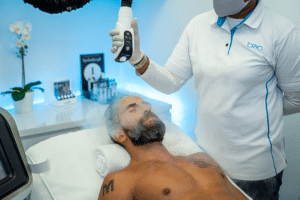Adequate sleep is vital for maintaining a healthy and balanced lifestyle. Not only is it important to get sufficient sleep, but it’s also crucial to ensure that the sleep you get is deep and aligns with your body’s circadian rhythm. This article explores the significance of sleep, circadian rhythm, cellular balance, and how red light therapy can improve the quality of your rest.
Sleep: A Cornerstone of Health and Balance
Sleep plays a crucial role in promoting good health and optimal physical performance. Just like eating nutritious food, staying hydrated, or being active, you cannot compromise on restful sleep if you want to maintain your health, appearance, and prevent chronic health issues. Sleep also plays a crucial role in preserving cellular balance, which is a key component of good health. Your cells and body require adequate sleep to function at their best.
When your cells are functioning efficiently and creating energy without excessive inflammation and oxidative stress, your body feels and functions better. On the other hand, lack of quality sleep can have negative systemic effects on the body and disrupt cellular balance. On the other hand, good sleep gives your body and cells the time and energy they need to thrive. Unfortunately, sleeping problems are a common issue among adults. In this article, we’ll look at some common reasons for poor sleep and its impact on health, as well as offer tips for better sleep.
The Consequences of Poor Sleep
In the short term, sleep deprivation affects our mood and reduces our alertness, making us less productive and more prone to erratic decisions. In the long term, chronic sleep problems contribute to numerous physical health issues. It’s a widespread problem, with an estimated 50-70 million Americans suffering from chronic sleep disorders and over 65% of adults reporting insufficient good sleep each week.
Here are three major negative health effects associated with chronic sleep problems:
Inflammation: Short-term sleep loss makes it difficult to balance our body’s natural inflammatory response, leading to increased inflammation. Elevated levels of inflammation are commonly found in individuals who sleep for longer periods than recommended, highlighting that both too little and too much sleep can cause inflammation.
Weight gain: Poor sleep can throw your body and cells off balance, leading to digestive, metabolic, and weight issues. Your internal organs work best when your eating is aligned with your circadian rhythm. Maintaining a consistent schedule with your eating and sleep allows your body to operate in a more efficient manner, which is beneficial for digestion, nutrient absorption, and metabolism. Limiting your food intake to a specific time window is also ideal.
Decreased mental acuity: There is a general consensus among experts that lack of sleep leads to slower response times, decreased alertness, and unreliable judgment and performance. Recent research suggests that sleep deprivation may particularly affect cognitive functions that rely on emotional data, making it clear why a lack of sleep can cause crankiness.
Light’s Major Role in Your Sleep Cycle
Sleep problems are familiar to many people, but not many realize the central role that light plays in our sleep cycle. Moreover, different types of light have varying effects on healthy sleep and circadian rhythm.
The brain interprets light as a signal for when to be asleep and awake. The circadian rhythm is naturally synchronized with the sun, but the bright lights and screens of modern life can disrupt our body’s natural signals and rhythms. So, which color light is best for sleep?
The Best Color Light for Sleep
An excessive exposure to blue light can cause headaches and make it harder to fall asleep and stay asleep. When we’re exposed to bright blue light from laptops, TVs, and phones, especially before bedtime,
Red Light Therapy and Improved Sleep
Red light therapy is a non-invasive, natural treatment that uses red and near-infrared light to help improve sleep, reduce inflammation, and promote cellular balance. Unlike blue light, which disrupts sleep hormones and makes it harder to fall asleep, red light therapy has been shown to help regulate the circadian rhythm and improve the quality of sleep.
In one study, participants who used red light therapy for just 30 minutes a day before bedtime reported improved sleep quality, decreased sleep latency, and reduced symptoms of insomnia. Other studies have found that red light therapy can help improve sleep quality in people with sleep-wake cycle disturbances, depression, and anxiety.
The Benefits of Red Light Therapy
In addition to improved sleep, red light therapy has been shown to have a range of benefits for physical and mental health. Here are a few of the most well-studied benefits of red light therapy:
Reduced Inflammation: Inflammation is a natural response to injury or stress, but chronic inflammation can contribute to a host of health problems. Red light therapy has been shown to reduce inflammation and oxidative stress, which can help improve overall health and prevent chronic diseases.
Improved Mood and Mental Health: Studies have shown that red light therapy can help improve mood, decrease anxiety and depression symptoms, and improve cognitive function in individuals with mild cognitive impairment.
Improved Skin Health: Red light therapy has been shown to improve skin health by increasing collagen production, reducing fine lines and wrinkles, and improving skin texture and tone.
In conclusion, red light therapy is a safe and effective way to improve sleep and overall health. Whether you struggle with sleep problems or simply want to optimize your health, incorporating red light therapy into your routine could help you get the restful, rejuvenating sleep you need.






































